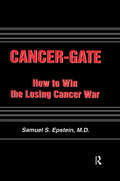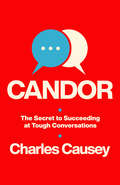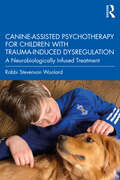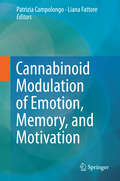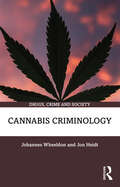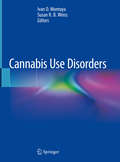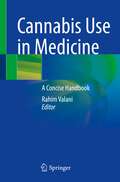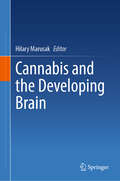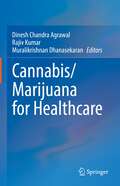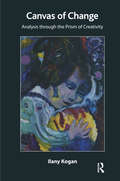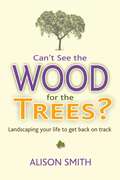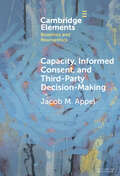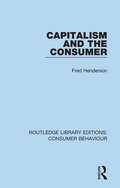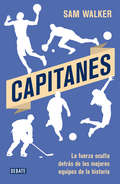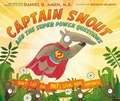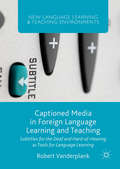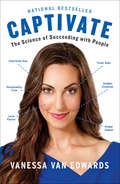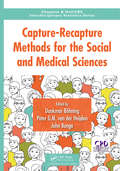- Table View
- List View
Cancer-gate: How to Win the Losing Cancer War (Policy, Politics, Health and Medicine Series)
by Samuel S. EpsteinAward-winning author, Samuel S. Epstein, M.D., whose 1978 book ""The Politics of Cancer"" shook the political establishment by showing how the federal government had been corrupted by industrial polluters, has written a book that is sure to be of equal consequence. ""Cancer-Gate: How to Win the Losing Cancer War"" is a groundbreaking new book. It warns that, contrary to three decades of promises, we are losing the winnable war against cancer, and that the hand-in-glove generals of the federal National Cancer Institute (NCI) and the private ""nonprofit"" American Cancer Society (ACS) have betrayed us.These institutions, Epstein alleges, have spent tens of billions of taxpayer and charity dollars primarily targeting silver-bullet cures, strategies that have largely failed, while virtually ignoring strategies for preventing cancer in the first place. As a result, cancer rates have escalated to epidemic proportions, now striking nearly one in every two men, and more than one in every three women. This translates into approximately 50 percent more cancer in men, and 20 percent more cancer in women over the course of just one generation.
Candor: The Secret to Succeeding at Tough Conversations
by Charles CauseyOvercome the fear of speaking truth by learning to do it with love.In a society where sensitivities take precedence over honesty, it can often feel impossible to openly speak your mind. From managing conflict resolution in the workplace to navigating differences at home, many issues remain unaddressed and unresolved when you cannot speak clearly, candidly, and truthfully for fear of negative consequences.It&’s time to learn how to speak the truth in love. In Candor, you&’ll learn how truth and love together can unlock pathways to more effective leadership and relationships—even in a day and age when many remain silent for fear of speaking up. Discover how speaking with sensitive and effective candor can reshape your relationships and enable you to live a life of honesty and freedom.
Candor: The Secret to Succeeding at Tough Conversations
by Charles CauseyOvercome the fear of speaking truth by learning to do it with love.In a society where sensitivities take precedence over honesty, it can often feel impossible to openly speak your mind. From managing conflict resolution in the workplace to navigating differences at home, many issues remain unaddressed and unresolved when you cannot speak clearly, candidly, and truthfully for fear of negative consequences.It&’s time to learn how to speak the truth in love. In Candor, you&’ll learn how truth and love together can unlock pathways to more effective leadership and relationships—even in a day and age when many remain silent for fear of speaking up. Discover how speaking with sensitive and effective candor can reshape your relationships and enable you to live a life of honesty and freedom.
Canine Cognition and the Human Bond (Nebraska Symposium on Motivation #69)
by Jeffrey R. StevensDogs are a valued part of millions of households worldwide. They also serve many functions in human societies from herding livestock to detecting drugs, explosives, or illegal wildlife to providing physical assistance or emotional support to those in need. Yet, in terms of behavior and cognition, dogs have only become a serious subject of scientific study in the last 20 years. Similarly, we have recently witnessed a sharp increase in studies of canine-human interaction, exploring the motivational, emotional, cognitive, physiological, and neural mechanisms of dogs on human psychology and well-being. This book is a collection of chapters stemming from the Nebraska Symposium on Motivation, which focused on Canine Cognition and the Human Bond. The primary goal of this symposium was to bring together researchers from psychology, biology, neuroscience, and anthropology to delve deeper into the canine-human bond. These chapters describe the current state of knowledge from international experts in the fields of canine cognition and canine-human interaction. Bridging these two areas can help us better understand the canine-human bond, potentially improving the lives of both dogs and people.
Canine-Assisted Interventions: A Comprehensive Guide to Credentialing Therapy Dog Teams
by John-Tyler Binfet Elizabeth Kjellstrand HartwigCovering principles of therapy dog team training, assessment, skills, and ongoing monitoring, Canine-Assisted Interventions provides guidance on the most evidence-based methods for therapy dog team welfare, training, and assessment. The authors offer a linear approach to understanding all aspects of the screening, assessment, and selection of dog-handler teams by exploring the journey of dog therapy teams from assessment of canines and handlers to the importance of ongoing monitoring, recredentialing, and retirement. In addition to reviewing key findings within the field of human-animal interactions, each chapter emphasizes skills on both the human and dog ends of the leash and makes recommendations for research-informed best practices. To support readers, the book culminates with checklists and training resources to serve as a quick reference for readers. This book will be of great interest for practitioners, in-service professionals, and researchers in the fields of canine-assisted interventions and counseling.
Canine-Assisted Psychotherapy for Children with Trauma-Induced Dysregulation: A Neurobiologically Infused Treatment
by Robbi Stevenson WoolardThis book provides mental health researchers and clinicians with valuable insight into the pathway that leads from developmental trauma to dysregulation and psychopathology. Incorporating science that explains the impact of early trauma, this book details the theory, mechanisms, and applications of neurobiologically informed canine-assisted psychotherapy, using illuminating case studies that demonstrate the efficacy of the author’s model.
Cannabinoid Modulation of Emotion, Memory, and Motivation
by Patrizia Campolongo Liana FattoreThe endocannabinoid system consists of cannabinoid receptors, their endogenous lipid ligands (endocannabinoids) and the enzymatic machinery for their synthesis and degradation. In the brain, endocannabinoids regulate ion channel activity and neurotransmitter release and thereby contribute to various aspects of brain function, including memory, reward and emotions. Their ability to modulate synaptic efficacy has a wide range of functional consequences and provides unique therapeutic possibilities. Unprecedented advances have been made in the understanding of the role of endocannabinoids in the regulation of the emotional brain over the past few years. However, a comprehensive book encompassing all these aspects is still lacking. The book will provide an overview of the role played by the endocannabinoid system in the regulation of emotional processes with particular emphasis on the modulation of memory and reward for emotionally arousing events and for the regulation of motivational aspects in cannabis use.
Cannabis Criminology (Drugs, Crime and Society)
by Johannes Wheeldon Jon HeidtCannabis Criminology explores the prohibition, decriminalization, and liberalization of cannabis policy through the lens of criminological and sociological theory, essential concepts, and cannabis research. It does so by focusing on five thematic areas: law, society, and social control; police and policing; race, ethnicity, and criminalization; the economics of cannabis use; and cannabis use and crime. It is the first book on cannabis since President Joe Biden signed an executive order in 2022 to pardon citizens and lawful permanent residents convicted of simple cannabis possession under federal law and DC statute. Cannabis is now legal in some form in 37 US states. To understand the reform of cannabis policy and the challenges to come, we first need to understand the connections between cannabis and criminology. The book links key areas in past and contemporary cannabis research to criminological and sociological theories, including key concepts, emergent concerns, and new directions. Based on an up-to-date review of this growing area of research, the book outlines a research program based on five essential thematic areas. Introducing cannabis as a critical case study in moral-legal re-negotiation, it outlines how cannabis prohibition has influenced cannabis around the world. Five discrete chapters focus on thematic areas, criminological and sociological theories, define essential concepts, and provide research focused on law, society, and social control (Chapter 2), police and policing cannabis (Chapter 3), race, ethnicity, and criminalization (Chapter 4), the economics of cannabis (Chapter 5), and cannabis and crime (Chapter 6). The book concludes by presenting new ways to engage prohibitionist thinking, by challenging myths, embracing social media, and developing a duty of care to guide future cannabis researchers and explicitly involve people who use cannabis. Cannabis Criminology will be of interest to a variety of readers, including students and scholars from a range of backgrounds studying drug use, drug policy, cannabis legalization, and other drug-related issues. It will also appeal to policymakers who want to know more about cannabis legalization and drug prohibition, those working in the criminal justice system, and social work professionals. Due to its accessible style, people involved in the cannabis industry, as well as cannabis users may also find the book interesting.
Cannabis Use Disorders
by Ivan D. Montoya Susan R. WeissThis book is an unbiased scientific compendium documenting the state-of-the-art in the etiology, diagnosis and treatment of Cannabis Use Disorders (CUD). Unlike any other current medical text, this volume focuses on the scientific aspects of CUDs and provides a resource for researchers, physicians and other health care providers who treat patients suffering from the disorder or its consequences. It begins by establishing the landscape of the disorder, including its prevalence, association with disabilities and comorbidities, and frequency of patients seeking treatment. The text delves into the complexity of the disorder in today’s environment by including the discoveries on the nature and extent of the endocannabinoid system as well as potential breakthroughs in safe and effective pharmacological and nonpharmacological treatments. Experts in the field contribute discussions on the most cutting-edge diagnostic and biological topics, including genetics, medical consequences, and clinical manifestations. The text also covers the challenges and risks presented by external factors, including social repercussions, protective factors, psychiatric comorbidities, withdrawal, and treatment services. Cannabis Use Disorders is a vital resource for researchers, psychiatrists, psychologists, addiction medicine specialists, toxicologists, hospital administrators, nurses, social workers, and all health care professionals working with patients who misuse cannabis.
Cannabis Use in Medicine: A Concise Handbook
by Rahim ValaniThis book examines the effectiveness of a unique area of patient care, cannabis use in medicine. While many American states have legalized medical marijuana, the FDA still has not approved it as a treatment due to a lack of studies to prove its validity.Countries such as Canada and Uruguay, on the other hand, have legalized cannabis. This book aids in accelerating the medical legitimacy of cannabis through comprehensive coverage of its uses, legality, pharmacology, and potential issues. Organized into three parts, the book begins with topics that function as an introduction to cannabis for medical use, such as patient assessments, the role of genetics, evidence-based therapy reviews, legal aspects, and pharmacology. Subsequent chapters then delve into the practical applications of medical cannabis use, including treatment for gastrointestinal disorders, neurological diseases, rheumatic diseases, and pain management. The book's final section features crucial discussions on the potential complications and adverse events in cannabis use, as well as occupation and pediatric considerations. Nuanced and timely, Cannabis Use in Medicine, is a vital resource for medical practitioners of all specialties looking to add cannabis to their repertoire of therapies.
Cannabis and Young People: Reviewing the Evidence
by Richard JenkinsCannabis is at the centre of ongoing controversial and often confused debate. Opinions on its potential impact on health are sharply divided: some argue that it poses serious risks to mental health and that adolescent use may lead to psychotic illness in young adulthood, or that it acts as a gateway to hard drugs such as cocaine or opiates. Conversely, others point to alcohol or tobacco being far more harmful yet entirely legal. Cannabis and Young People aims to shed light on the current debates by reviewing all the available evidence on a range of issues relating to the use of cannabis among children and adolescents and summarizing the main conclusions in clear, jargon-free language. Areas covered include: * Patterns of cannabis use * Changes in usage * Young people's views on cannabis * The potential harmful effects, including mental health problems, educational attainment, antisocial behaviour * The family and social factors that can initiate cannabis use * The progression to regular use * The effects of decriminalization This book will be an essential read for anyone needing informed, authoritative information about cannabis and its effects.
Cannabis and the Developing Brain
by Hilary MarusakThis book draws on the latest scientific research to explore the potential impact of cannabis use on the developing brain. The authors first describe the endocannabinoid system and its role in shaping neurodevelopment and cognitive and emotion-related functioning throughout the lifespan. Then they discuss the effects of cannabis and cannabinoids on cognitive function, mental health, and brain structure and function during pregnancy, childhood, and adolescence. With a balanced and evidence-based approach, Cannabis and the Developing Brain provides comprehensive coverage of the emerging science in this area, helping researchers, policy makers, educators and parents who seek to navigate the complex landscape of cannabis use in youth and pregnant people.
Cannabis in Psychiatric Practice: A Practical Guide (Psychiatry Update #3)
by Paula Riggs Thida ThantThis book educates and familiarizes psychiatrists with the impact of cannabis beyond the scope of addiction and ways to effectively discuss the existing literature and knowledge with patients. Cannabis in Psychiatric Practice is organized by clinical setting to help tailor the literature to psychiatrists and other mental health clinicians working in all areas, whether traditional outpatient clinics, emergency departments, inpatient psychiatry or medical units. It helps readers, regardless of their training background, learn about the impact of cannabis on a variety of disorders in a manner adjusted to the unique needs and challenges of their particular treatment settings and patient populations. The book also includes clinical cases and practical tips integrating the current evidence, treatment approaches, and psychoeducation needed to effectively practice in the era of modern-day psychiatry and cannabis legalization. Chapters are written in a clear, easy-to-read style, allowing readers to reference specific portions of the book as needed, increasing its utility for the general psychiatrist and mental health clinician. With the increasing prevalence and availability of cannabis and CBD products, this book is an invaluable reference for psychiatrists who wish to explore the impact of cannabis in their clinical practice.
Cannabis on Campus: Changing the Dialogue in the Wake of Legalization
by Stephanie Field Jonathan BeazleyCannabis on Campus is a comprehensive resource on the implications of marijuana legalization for college campuses. It is essential reading for college administrators and other professionals responsible for overseeing drug policy and addressing marijuana use in higher education. The authors use their considerable experience in college alcohol and other drug (AOD) counseling to provide a sweeping look at the cannabis culture found in our universities. Chapters alternate between historical context, research and analysis, and student interviews, providing an evidence-based, nuanced understanding of the role of marijuana use in today’s college campuses, as well as insights and recommendations for a post-legalization future.
Cannabis/Marijuana for Healthcare
by Dinesh Chandra Agrawal Rajiv Kumar Muralikrishnan DhanasekaranThe book contains review articles providing a comprehensive overview of cannabis/marijuana’s diverse healing aspects in human healthcare (medicinal, nutraceutical, skincare, etc.). The research articles include the role of cannabis in cancer treatment, drug discovery, cosmeceutical potential, prophylactic and therapeutic use for treating neuropathic pain and migraine, pharmacokinetics, safety profile, and issues related to the consumption of cannabis/marijuana. Another salient feature of the book is a complete mapping and region- and sector-wise critical analysis of cannabis/marijuana patents on healthcare and future directions for the benefit of researchers and businesses/entrepreneurs interested in the rapidly advancing area of cannabis. The text describes cannabis/marijuana’s detailed legal aspects, production prospects, and applications for healthcare and recreational purposes in the USA. It traces the traditional roots of cannabis use in Turkey, Israel, the Middle East, Africa, and India. This unique compendium of articles will be useful as a reference book for students, researchers, academics, business houses, and all individuals interested in medicinal, nutraceutical, cosmeceutical, traditional, legal, and commercial aspects of cannabis usage.
Canvas of Change: Analysis Through the Prism of Creativity
by Ilany KoganThis book presents a detailed account of two analytic case studies examined through the particular viewpoint of creativity.The first part of the book contains a review of the classical and contemporary literature on the source and function of creativity. Creativity is then examined from the perspective of several analytic models - Freudian, Kleinian, and post-Kleinian. The second and third parts of the book present case illustrations that deal with the use of creative activity in analysis. The creative use of biblical stories in the case of David, or the use of paintings and poems in the case of Rachel, portrayed the inner reality of these patients. David's violent and incestuous biblical stories reflected his world of incestuous and destructive wishes towards his primary objects (and towards the therapist in the transference). Rachel's paintings and poems conveyed her unconscious conflicts, depressive fantasies and anxieties, stemming from her fusion with her mother who was a child Holocaust survivor. Working through their relationships with their primary objects and their self perception, as revealed by these creative activities in analysis, facilitated the patients' mourning.
Can’t See the Wood for the Trees?: Landscaping Your Life to Get Back on Track
by Alison SmithA guide to using the metaphorical language of a “stuck” situation to discover the solution • Shares an easy, fun process of exploring well-known sayings as a means to identify new solutions and get unstuck in life and work • Explains how to bring clarity to a problem, highlight alternative perspectives, bypass any conscious resistance to finding a solution, and allow solutions to emerge organically, from within ourselves • Details the author’s “Landscaping Your Life” method, which has been used successfully in business strategy development, team development, project problem resolution, and in one-to-one coaching If you can’t see the wood for the trees, feel like a fish out of water, or are going around in circles, we’ve got good news for you: that saying is also a clue to where you’ll find the solution. Yes, you read right--you can use the language you’re using to describe the stuck situation to discover the solution. It’s not even the language as much as the landscape contained within your description of the situation that can give you pointers. As Alison Smith explains, “If a picture paints a thousand words, then a metaphor paints a thousand pictures. In other words, the metaphor in the saying you’re using will provide a million words that will undoubtedly have the solution contained within them.” That’s what this book is all about--taking these sayings that you’re using to describe being stuck and using them to get unstuck again. The language you apply provides clues to how you perceive the current situation. Subconsciously, you know the solution. Exploring the metaphors contained within your language allows your subconscious to communicate to your conscious awareness more easily. The metaphor reduces resistance and the barriers we put up to change. It’s as if we enjoy exploring the metaphor and forget what it means in reality, and before we know it, we have a metaphorical solution that we cannot help but translate into real life. Offering an effective, easy process based on the power of metaphors, Alison Smith introduces her “Landscaping Your Life” method as a means to bring clarity to a problem, highlight alternative perspectives, and allow solutions to emerge organically, from within ourselves.
Capacity, Informed Consent and Third-Party Decision-Making (Elements in Bioethics and Neuroethics)
by Jacob M. AppelThis Element examines three related topics in the field of bioethics that arise frequently both in clinical care and in medico-legal settings: capacity, informed consent, and third-party decision-making. All three of these subjects have been shaped significantly by the shift from the paternalistic models of care that dominated medicine in the United States, Canada, and Great Britain prior to the 1960s to the present models that privilege patient autonomy. Each section traces the history of one of these topics and then explores the major ethics issues that arise as these issues are addressed in contemporary clinical practice, paying particular attention to the role that structural factors such as bias and social capital play in their use. In addition, the volume also discusses recent innovations and proposals for reform that may shape these subjects in the future in response both to technological advances and changes in societal priorities.
Capitalism and Desire: The Psychic Cost of Free Markets
by Todd McGowanDespite creating vast inequalities and propping up reactionary world regimes, capitalism has many passionate defenders—but not because of what it withholds from some and gives to others. Capitalism dominates, Todd McGowan argues, because it mimics the structure of our desire while hiding the trauma that the system inflicts upon it. People from all backgrounds enjoy what capitalism provides, but at the same time are told more and better is yet to come. Capitalism traps us through an incomplete satisfaction that compels us after the new, the better, and the more.Capitalism's parasitic relationship to our desires gives it the illusion of corresponding to our natural impulses, which is how capitalism's defenders characterize it. By understanding this psychic strategy, McGowan hopes to divest us of our addiction to capitalist enrichment and help us rediscover enjoyment as we actually experienced it. By locating it in the present, McGowan frees us from our attachment to a better future and the belief that capitalism is an essential outgrowth of human nature. From this perspective, our economic, social, and political worlds open up to real political change. Eloquent and enlivened by examples from film, television, consumer culture, and everyday life, Capitalism and Desire brings a new, psychoanalytically grounded approach to political and social theory.
Capitalism and the Consumer (Routledge Library Editions: Consumer Behaviour)
by Fred HendersonWritten at a time when the needs and influence of the consumer within the economic system were in their infancy, this book offers a valuable insight into the birth of consumer-led economics as an integral part of social structure and economic theory.
Capitanes
by Sam WalkerSam Walker examina en este fascinante ensayo la clave del éxito de los mejores equipos deportivos del mundo, y llega a sorprendentes conclusiones: la fuerza oculta detrás de los equipos más legendarios de la historia no es el entrenador, ni la estrella; no es el dinero ni la estrategia; es una cuestión totalmente distinta... Capitanes ha sido incluido en las listas:Top Business and Leadership Book de 2017 de Amazony 13 Best Business Books of 2017 de CNBC Hace diez años, Sam Walker decidió contestar la pregunta más controvertida sobre deporte: ¿cuáles son los equipos más exitosos de todos los tiempos? Mediante la estadística, identificó los 16 equipos con mayores triunfos a su espalda en todos los deportes, desde el fútbol, hasta el baloncesto, pasando por el rugby o el voleibol femenino. El siguiente paso era inevitable: ¿qué características en común tenían estos superequipos? Según avanzaba, Walker encontró un patrón: todos ellos tenían detrás un tipo muy especial de líder, un capitán, pero no el que uno esperaría. Eran anomalías heterodoxas, raros y poco sociables, no muy talentosos, malos comunicadores, rompían las reglas y, en vez de reclamar atención, preferían un segundo plano. Unos capitanes muy diferentes de lo que se espera de líderes inspiradores. A partir de equipos tan famosos como el F.C. Barcelona, la selección brasileña, los All Blacks o los New York Yankees, y otros menos conocidos como el equipo de hockey sobre hielo soviético o el de balonmano francés, Capitanes revela las siete cualidades fundamentales que un líder excepcional necesita. Basado en entrevistas exclusivas con atletas, entrenadores y dirigentes de decenas de países, Walker explica si los líderes nacen o se hacen, y por qué a veces se elige al capitán equivocado. No es solo un libro sobre deportes, es la clave de cómo se construyen grandes equipos y en qué se basa el liderazgo exitoso. Reseña:«Un buen libro sobre liderazgo que, muy inteligentemente, se hace pasar por un libro sobre deportes.»Andrew Ross Sorkin, The New York Times
Captain Snout And The Super Power Questions: Don't Let The Ants Steal Your Happiness
by Daniel AmenCaptain Snout and the Super Power Questions; Don’t Let the Ants Steal Your Happiness, written by board certified child psychiatrist Dr. Daniel Amen, playfully encourages children to correct their negative thinking patterns in order to live happier and healthier lives. Comical illustrations bring the story alive as our main character, Captain Snout, reveals the super power questions that can rid us of our automatic negative thoughts (ANTs) and lead to accurate and truthful thinking.
Captioned Media in Foreign Language Learning and Teaching: Subtitles for the Deaf and Hard-of-Hearing as Tools for Language Learning (New Language Learning and Teaching Environments)
by Robert VanderplankThis book brings together current thinking on informal language learning and the findings of over 30 years of research on captions (same language subtitles for the deaf and hard-of-hearing) to present a new model of language learning from captioned viewing and a future roadmap for research and practice in this field. Language learners may have normal hearing but they are 'hard-of-listening' and find it difficult to follow the rapid or unclear speech in many films and TV programmes. Vanderplank considers whether watching with captions not only enables learners to understand and enjoy foreign language television and films but also helps them to improve their foreign language skills. Captioned Media in Foreign Language Learning and Teaching will be of interest to students and researchers involved in second language acquisition teaching and research, as well as practising language teachers and teacher trainers.
Captivate: The Science of Succeeding with People
by Vanessa Van EdwardsDo you feel awkward at networking events? Do you wonder what your date really thinks of you? Do you wish you could decode people? You need to learn the science of people. As a human behavior hacker, Vanessa Van Edwards created a research lab to study the hidden forces that drive us. And she&’s cracked the code. In Captivate, she shares shortcuts, systems, and secrets for taking charge of your interactions at work, at home, and in any social situation. These aren&’t the people skills you learned in school. This is the first comprehensive, science backed, real life manual on how to captivate anyone—and a completely new approach to building connections. Just like knowing the formulas to use in a chemistry lab, or the right programming language to build an app, Captivate provides simple ways to solve people problems. You&’ll learn, for example… · How to work a room: Every party, networking event, and social situation has a predictable map. Discover the sweet spot for making the most connections. · How to read faces: It&’s easier than you think to speed-read facial expressions and use them to predict people&’s emotions. · How to talk to anyone: Every conversation can be memorable—once you learn how certain words generate the pleasure hormone dopamine in listeners. When you understand the laws of human behavior, your influence, impact, and income will increase significantly. What&’s more, you will improve your interpersonal intelligence, make a killer first impression, and build rapport quickly and authentically in any situation—negotiations, interviews, parties, and pitches. You&’ll never interact the same way again.
Capture-Recapture Methods for the Social and Medical Sciences (Chapman & Hall/CRC Interdisciplinary Statistics)
by Dankmar Bohning Peter G.M. van der Heijden John BungeCapture-recapture methods have been used in biology and ecology for more than 100 years. However, it is only recently that these methods have become popular in the social and medical sciences to estimate the size of elusive populations such as illegal immigrants, illicit drug users, or people with a drinking problem. Capture-Recapture Methods for the Social and Medical Sciences brings together important developments which allow the application of these methods. It has contributions from more than 40 researchers, and is divided into eight parts, including topics such as ratio regression models, capture-recapture meta-analysis, extensions of single and multiple source models, latent variable models and Bayesian approaches. <P><P>The book is suitable for everyone who is interested in applying capture-recapture methods in the social and medical sciences. Furthermore, it is also of interest to those working with capture-recapture methods in biology and ecology, as there are some important developments covered in the book that also apply to these classical application areas.
